The delivery services market is undergoing significant transformation as companies strive to expand their reach and capture greater market share. Through innovative offerings, strategic partnerships, and a focus on customer experience, leading players like Grubhub, Deliveroo, Uber, DoorDash, and Instacart are reshaping the way consumers access food and groceries. As the market continues to evolve, these companies are all trying new approaches to stay ahead of the curve.
Grubhub recently launched an in-app wallet feature aimed at increasing the average check size. This feature allows customers to store credits and apply them easily during checkout, incentivizing additional spending. By reducing friction at the point of sale, Grubhub hopes to encourage customers to add more items to their orders, thereby increasing overall revenue.
Grubhub is also investing in personalization technology to offer customized recommendations to users. This initiative is designed to enhance customer engagement by tailoring the homepage experience to individual preferences. Personalized recommendations not only improve user satisfaction but also drive repeat business, as customers are more likely to return to a platform that consistently offers relevant options.
In addition to these technological advancements, Grubhub has introduced priority delivery options, which allow customers to pay extra for faster service. This feature caters to time-sensitive orders, providing an additional revenue stream for the company.
Uber has taken a unique approach by integrating multiple services—such as ride-hailing, food delivery (Uber Eats), and grocery delivery—into a single platform. This strategy not only provides convenience to customers but also increases the likelihood of cross-service utilization.
According to Uber, 35% of its customers use multiple services, leading to higher overall spending per customer. This integrated approach allows Uber to capture a larger share of the customer's wallet, as users are more likely to stick with a platform that meets a variety of their needs.
Uber's multi-service strategy is also designed to enhance customer loyalty and retention. By offering a range of services within a single app, Uber can create a more cohesive and engaging user experience. This, in turn, reduces the likelihood of customers switching to competitors. Uber's loyalty programs, such as Uber Rewards, further incentivize customers to use multiple services by offering discounts and perks based on their usage.
DoorDash and Instacart are both heavily focused on capturing a larger share of the grocery delivery market. DoorDash, traditionally known for restaurant delivery, has made significant inroads into grocery delivery by partnering with major supermarket chains. The company's strategy involves leveraging its extensive delivery network to provide fast and reliable grocery delivery services.
Instacart, which has always specialized in grocery delivery, continues to innovate in this space. The company is investing in technology that enhances the customer experience, such as real-time inventory updates and personalized shopping recommendations. Instacart is also exploring new pricing models, such as subscription-based services, to attract more customers and increase loyalty.
Deliveroo has identified grocery delivery as a significant growth opportunity, especially as consumer demand for quick and convenient grocery solutions continues to rise. The company has seen a notable increase in grocery orders, indicating that its strategy to diversify beyond restaurant delivery is paying off. By partnering with supermarkets and local grocers, Deliveroo is tapping into a market segment that has traditionally been underserved by delivery platforms.
To support this expansion, Deliveroo is investing in technology that streamlines the grocery ordering process, including managing inventory in real-time and ensuring the freshness of perishable items. Deliveroo's focus on technology and user experience is critical in differentiating its service from competitors.
Deliveroo's partnerships with grocery retailers are a key component of its market penetration strategy. By collaborating with well-known supermarket chains, Deliveroo can offer a wide range of products, appealing to a broader customer base. These partnerships also allow Deliveroo to leverage the existing infrastructure of grocery stores, reducing the logistical challenges associated with scaling a grocery delivery service.
DoorDash and Instacart are both heavily focused on capturing a larger share of the grocery delivery market. DoorDash, traditionally known for restaurant delivery, has made significant inroads into grocery delivery by partnering with major supermarket chains. The company's strategy involves leveraging its extensive delivery network to provide fast and reliable grocery delivery services.
Instacart, which has always specialized in grocery delivery, continues to innovate in this space. The company is investing in technology that enhances the customer experience, such as real-time inventory updates and personalized shopping recommendations. Instacart is also exploring new pricing models, such as subscription-based services, to attract more customers and increase loyalty.
Both DoorDash and Instacart are forming strategic partnerships to expand their reach. For example, DoorDash has partnered with national grocery chains to offer delivery services across multiple regions. Instacart, on the other hand, is focusing on forming partnerships with smaller, regional grocers to provide a more localized service. These partnerships are essential for both companies to gain market share in a highly competitive environment.
For companies like Deliveroo and Instacart, real-time data and inventory management are critical to ensuring the success of their grocery delivery services. These technologies allow platforms to provide accurate information about product availability, reducing the likelihood of out-of-stock items and enhancing customer satisfaction. Real-time data also enables companies to optimize their delivery routes, improving efficiency and reducing delivery times.
Regulatory pressures are also impacting the delivery market, particularly in terms of labor laws and the classification of gig workers. Companies must adapt to changing regulations while maintaining their business models. Additionally, the competitive landscape is becoming increasingly crowded, with new entrants and existing players vying for market share. Delivery companies must continuously innovate and differentiate themselves to stay ahead of the competition.










